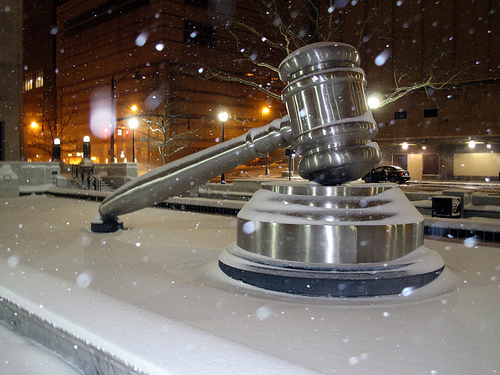Last week I conducted a workshop for Honors students called “Notetaking for the 21st Century” (if you’re interested, my “online handout” and Prezi are posted on my site). I began by reflecting on what research was like when I began graduate school (in 1992, now called “back in the day”). Let’s rewind…
I took paper notes (usually index cards) on paper sources. I looked up sources in printed, bound indexes to paper or microfilm (or microfiche… or microcard*!) sources, and then went to the stacks and the metal filing cabinets, got those sources, took notes on them or used expensive film/fiche/Xerox printers to make paper copies of them, and then stored them in binders or file folders. I have several file boxes of such materials for my undergraduate senior thesis and my doctoral dissertation. Really, it was all post-computer but pre-internet, although I did use some CD-ROM indexes to scholarly periodicals. The standby reference work in our degree program was Francis Paul Prucha, Handbook for Research in American History: A Guide to Bibliographies and Other Reference Works (1987 edition).
I hadn’t thought about that book or the nearly-quaint research techniques that were my bread and butter, until I was getting ready for this last week’s session on Government Documents in the methods course. I remembered that Prucha had a fairly comprehensive overview chapter about public records and government sources, and although the places you find such documents is increasingly (though not exclusively) online, the structure of government and the kinds of documents they create haven’t changed all that much. Sure enough, the book was still there, gathering dust on my shelf, but his list was still a helpful starting point for an outline.
Government Documents (my presentation’s posted here on the course website)
–“Government” = U.S. Federal & its Agencies; State; County; Local; Tribal
–Foundational Documents = Constitutions, Charters &Â their Antecedents
–Executive Branch = White House Papers, Cabinet Papers, Executive Orders, Commissions & Reports, Administration Rulings and Regulations, Foreign Affairs of the State Department
–Legislative Branch, i.e. Congress = Congressional Proceedings, Debates, Bills and Resolutions, Committee Proceedings, Congressional Hearings, Reports, Directories, Documents and reports that Congress ordered to be printed, Federal Laws (the Statutes at Large), Treaties
Judicial Branch = State Courts, District Courts, US Courts of Appeal, SCOTUS
Federal Agencies = here’s an 11-page list of ’em
I also talked about special classification/nomenclature with respect to government documents, including SuDoc numbers, LC Subject Headings, and Supreme Court case citation.
 For the “workshop day” we could have gone any direction, really. It would have been dynamite to take a trip to the Gov Docs section of our nearest depository library, or to focus in on Congressional hearings or any other category of GovDoc that could be accessed online (e.g. publications at the GPO or the Congressional Serial Set – for lots of other ideas, see the list of resources and links at the original class post). We focused in on Supreme Court decisions.
For the “workshop day” we could have gone any direction, really. It would have been dynamite to take a trip to the Gov Docs section of our nearest depository library, or to focus in on Congressional hearings or any other category of GovDoc that could be accessed online (e.g. publications at the GPO or the Congressional Serial Set – for lots of other ideas, see the list of resources and links at the original class post). We focused in on Supreme Court decisions.
My students, in groups of 4, chose Supreme Court cases that they were interested in reading for the next class. In retrospect it probably would have been good to choose a case that had dissenting and concurring opinions, since these three all turned out to be unanimous decisions – but I guess that kept it simple, too. They selected Marbury v. Madison, Brown v. Board of Education, and Hustler Magazine v. Falwell (an intriguing juxtaposition and range of constitutional issues, as it turns out). Two of them can be found on the OurDocuments.gov website & the third at Oyez and Justia; Streetlaw also has a good list of landmark decisions with lesson plans and resources.
In our next class we worked in groups, working through the cases and the text of the decisions themselves, then presenting them to the rest of the class. Our overall guiding topic for the day was “Supreme Court Jeopardy:” If this case is the answer, what was the historical research question? For what kinds of questions are SCOTUS cases good evidence? — which sparked a lively discussion. One student made the interesting observation that the Supreme Court is one of the more transparent government branches, with all of its decisions (if not perhaps its decision-making) made completely available to anyone who cares to read them, which he found very heartening. No wiki or leaks needed. I think the vastness of the government documents area was both eye-opening and overwhelming… they (and frankly I) had no idea how much was available and how expansive a source base this can be.
*What’s a microcard, you ask? Brandeis had an entire set of Early American Imprints reproduced on microcard; since I wasn’t a colonialist I rarely used them, but if you’re curious… here’s a talk on microcard technology and research… from 1948!
Image credit: Sculpture outside the Ohio Supreme Court, by Andrew Scott/afsart, used under Creative Commons license













